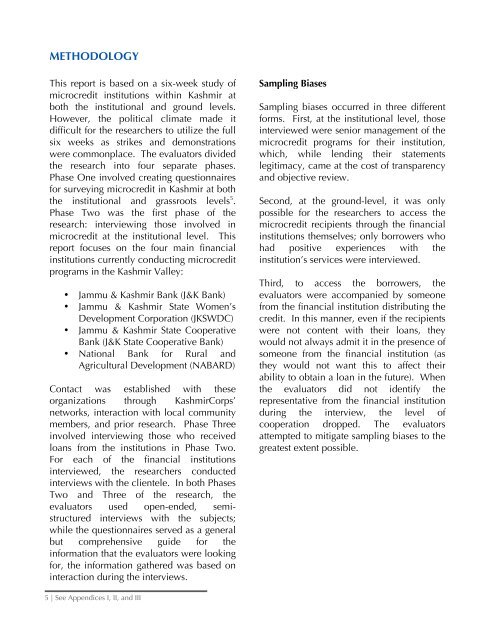State of Microfinance in J&K - KashmirCorps
State of Microfinance in J&K - KashmirCorps
State of Microfinance in J&K - KashmirCorps
You also want an ePaper? Increase the reach of your titles
YUMPU automatically turns print PDFs into web optimized ePapers that Google loves.
METHODOLOGY<br />
This report is based on a six-week study <strong>of</strong><br />
microcredit <strong>in</strong>stitutions with<strong>in</strong> Kashmir at<br />
both the <strong>in</strong>stitutional and ground levels.<br />
However, the political climate made it<br />
difficult for the researchers to utilize the full<br />
six weeks as strikes and demonstrations<br />
were commonplace. The evaluators divided<br />
the research <strong>in</strong>to four separate phases.<br />
Phase One <strong>in</strong>volved creat<strong>in</strong>g questionnaires<br />
for survey<strong>in</strong>g microcredit <strong>in</strong> Kashmir at both<br />
the <strong>in</strong>stitutional and grassroots levels 5 .<br />
Phase Two was the first phase <strong>of</strong> the<br />
research: <strong>in</strong>terview<strong>in</strong>g those <strong>in</strong>volved <strong>in</strong><br />
microcredit at the <strong>in</strong>stitutional level. This<br />
report focuses on the four ma<strong>in</strong> f<strong>in</strong>ancial<br />
<strong>in</strong>stitutions currently conduct<strong>in</strong>g microcredit<br />
programs <strong>in</strong> the Kashmir Valley:<br />
• Jammu & Kashmir Bank (J&K Bank)<br />
• Jammu & Kashmir <strong>State</strong> Women’s<br />
Development Corporation (JKSWDC)<br />
• Jammu & Kashmir <strong>State</strong> Cooperative<br />
Bank (J&K <strong>State</strong> Cooperative Bank)<br />
• National Bank for Rural and<br />
Agricultural Development (NABARD)<br />
Contact was established with these<br />
organizations through <strong>KashmirCorps</strong>’<br />
networks, <strong>in</strong>teraction with local community<br />
members, and prior research. Phase Three<br />
<strong>in</strong>volved <strong>in</strong>terview<strong>in</strong>g those who received<br />
loans from the <strong>in</strong>stitutions <strong>in</strong> Phase Two.<br />
For each <strong>of</strong> the f<strong>in</strong>ancial <strong>in</strong>stitutions<br />
<strong>in</strong>terviewed, the researchers conducted<br />
<strong>in</strong>terviews with the clientele. In both Phases<br />
Two and Three <strong>of</strong> the research, the<br />
evaluators used open-ended, semistructured<br />
<strong>in</strong>terviews with the subjects;<br />
while the questionnaires served as a general<br />
but comprehensive guide for the<br />
<strong>in</strong>formation that the evaluators were look<strong>in</strong>g<br />
for, the <strong>in</strong>formation gathered was based on<br />
<strong>in</strong>teraction dur<strong>in</strong>g the <strong>in</strong>terviews.<br />
Sampl<strong>in</strong>g Biases<br />
Sampl<strong>in</strong>g biases occurred <strong>in</strong> three different<br />
forms. First, at the <strong>in</strong>stitutional level, those<br />
<strong>in</strong>terviewed were senior management <strong>of</strong> the<br />
microcredit programs for their <strong>in</strong>stitution,<br />
which, while lend<strong>in</strong>g their statements<br />
legitimacy, came at the cost <strong>of</strong> transparency<br />
and objective review.<br />
Second, at the ground-level, it was only<br />
possible for the researchers to access the<br />
microcredit recipients through the f<strong>in</strong>ancial<br />
<strong>in</strong>stitutions themselves; only borrowers who<br />
had positive experiences with the<br />
<strong>in</strong>stitution’s services were <strong>in</strong>terviewed.<br />
Third, to access the borrowers, the<br />
evaluators were accompanied by someone<br />
from the f<strong>in</strong>ancial <strong>in</strong>stitution distribut<strong>in</strong>g the<br />
credit. In this manner, even if the recipients<br />
were not content with their loans, they<br />
would not always admit it <strong>in</strong> the presence <strong>of</strong><br />
someone from the f<strong>in</strong>ancial <strong>in</strong>stitution (as<br />
they would not want this to affect their<br />
ability to obta<strong>in</strong> a loan <strong>in</strong> the future). When<br />
the evaluators did not identify the<br />
representative from the f<strong>in</strong>ancial <strong>in</strong>stitution<br />
dur<strong>in</strong>g the <strong>in</strong>terview, the level <strong>of</strong><br />
cooperation dropped. The evaluators<br />
attempted to mitigate sampl<strong>in</strong>g biases to the<br />
greatest extent possible.<br />
5 | See Appendices I, II, and III



![Education in Kashmir [Arshad].pdf - KashmirCorps](https://img.yumpu.com/12199470/1/190x245/education-in-kashmir-arshadpdf-kashmircorps.jpg?quality=85)